Auctions
It Wasn’t Just KAWS. Here Are 3 Trends That Show the Hong Kong Auction Market Is Booming for International Art
We examine three trend lines from the recent slate of Hong Kong sales to determine where the market is headed.
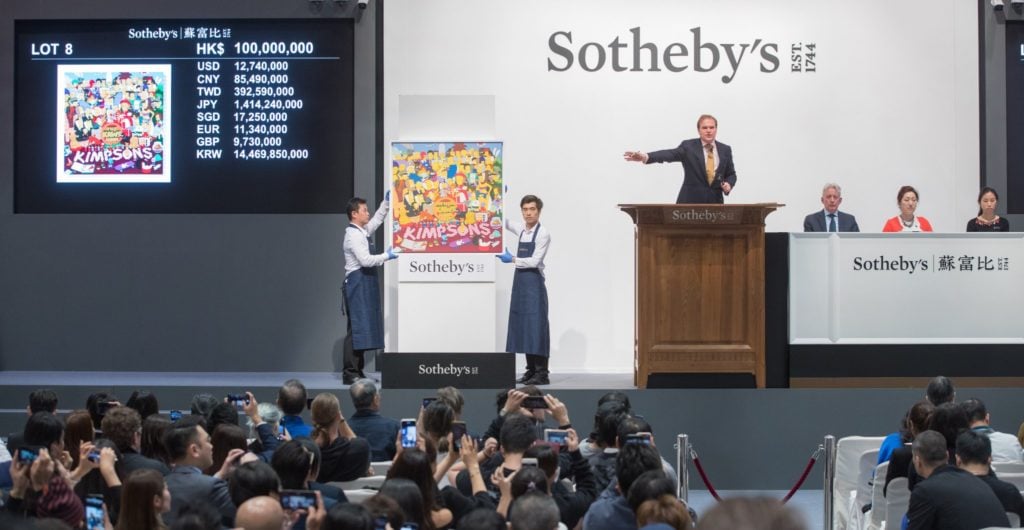
We examine three trend lines from the recent slate of Hong Kong sales to determine where the market is headed.

Julia Halperin &
Tim Schneider

Like a massive Companion balloon in Macy’s Thanksgiving Day Parade, the mind-boggling $14.8 million paid for a KAWS painting in Hong Kong earlier this month upstaged every other result from Sotheby’s recent series of sales in the city. But it turns out a welter of other head-turning market activity took place in the shadow of that hulking figure.
Sotheby’s sales—held at the same time as a buoyant, if uneven, Art Basel Hong Kong—exceeded expectations, surpassing the high estimate of $428 million to generate $482 million, the second-highest total in the company’s history in the city. (All totals include premiums unless otherwise noted.)
But select big numbers only tell us so much. To put these results into context, we dove into the data to determine how the market in Hong Kong has evolved over the past decade—and where it’s headed next.
Our findings suggest that the city, which serves as a hub for collectors across Asia, is well on its way to becoming a mature, global market. And while work by Asian artists still dramatically outperforms that by Western artists, the latter is gaining serious momentum.
Below, a closer look at our three big takeaways.
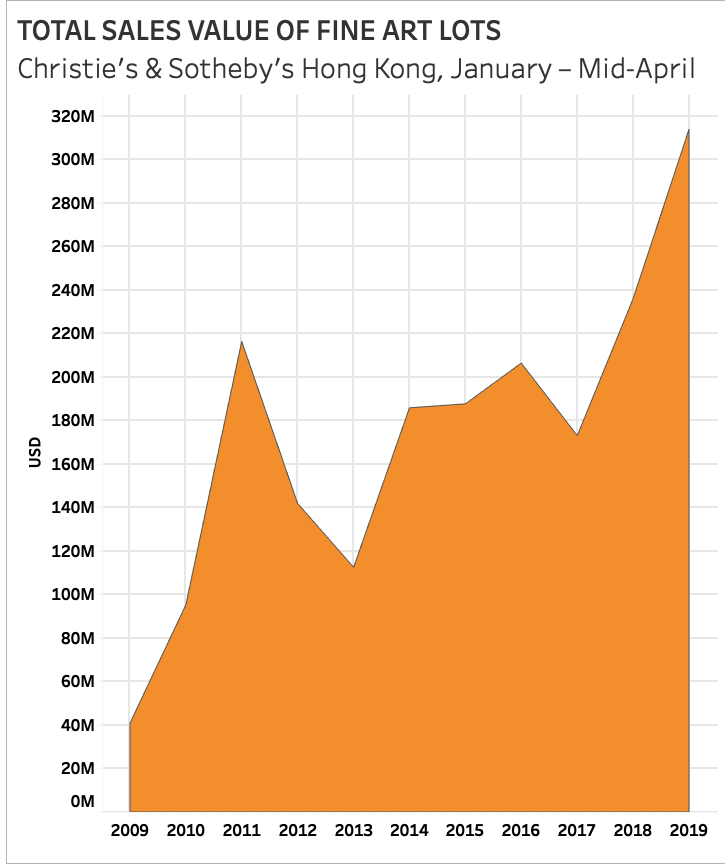
© artnet Price Database 2019.
You don’t need to be a statistician to recognize that this tally of fine-art sales at Christie’s and Sotheby’s Hong Kong in the opening months of 2009 through 2019 shows a market on the rise. The past two years have seen an enormous increase in sales in the region.
This year hit a new high mark with a total of $313.9 million worth of auction sales in Hong Kong since January 1, a 33 percent increase from the $236 million sold in the first three and a half months of 2018. Both this year and last year’s totals handily surpassed the previous high mark in 2011, when total sales hit $216.4 million.
But while the 2011 total was boosted by massive growth in the mainland Chinese economy at the time—and purchases by speculators who were riding that wave—the more recent results have gone against the economic tide. Last year, the Chinese economy experienced slower growth than it has at any point in the past 28 years. But you wouldn’t know it from the recent activity in the auction room.
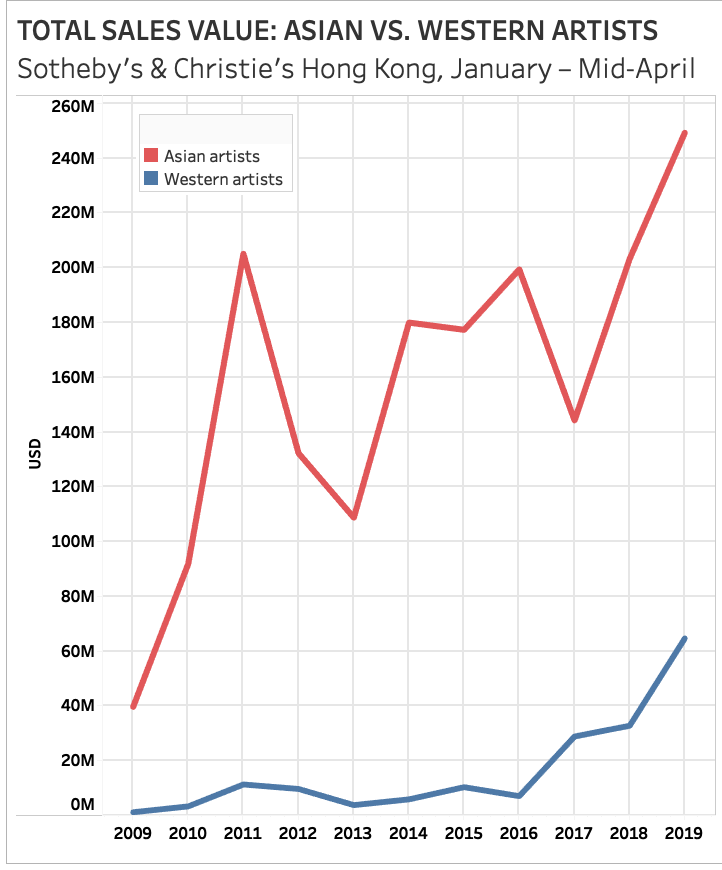
© artnet Price Database 2019.
Due to an exodus of speculators and the rise of a younger, more internationally focused collector base, the recent report on the state of the Chinese art market from the European Fine Art Foundation suggested that storm clouds are gathering over Asian artists there. The fear was that new buyers’ desire for brand names and the recent influx of Western blue-chip galleries might cannibalize the business both of Asian dealers and auction houses offering work by Asian artists.
While that could still be a concern long-term, the latest results show it’s certainly not happening yet. Asian and non-Asian artists alike posted their best years ever at auction in 2019. But Asian artists still drastically outsold Westerners, in terms of both total sales value ($249 million vs. $65 million) and volume of works sold (756 lots sold vs. 152 lots sold).
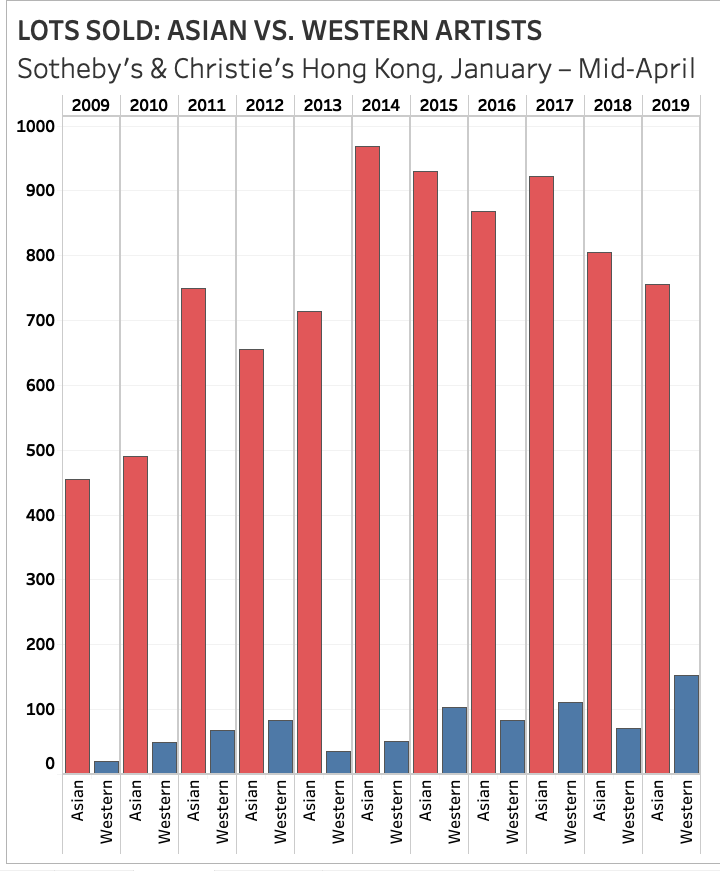
© artnet Price Database 2019.
The recent spate of sales in Hong Kong also saw the continued strong performance of brand-name Asian artists, such as Zao Wou-Ki, whose Untitled (1958), deaccessioned by the Solomon R. Guggenheim Museum, sold for $14.8 million, well above its $10 million high estimate.
“There is increasing interest in Western art, but it’s not a matter of squeezing people out—it’s a matter of the market expanding,” Angela Jaeyoung Chun of Arario Gallery told artnet News during Art Basel Hong Kong.
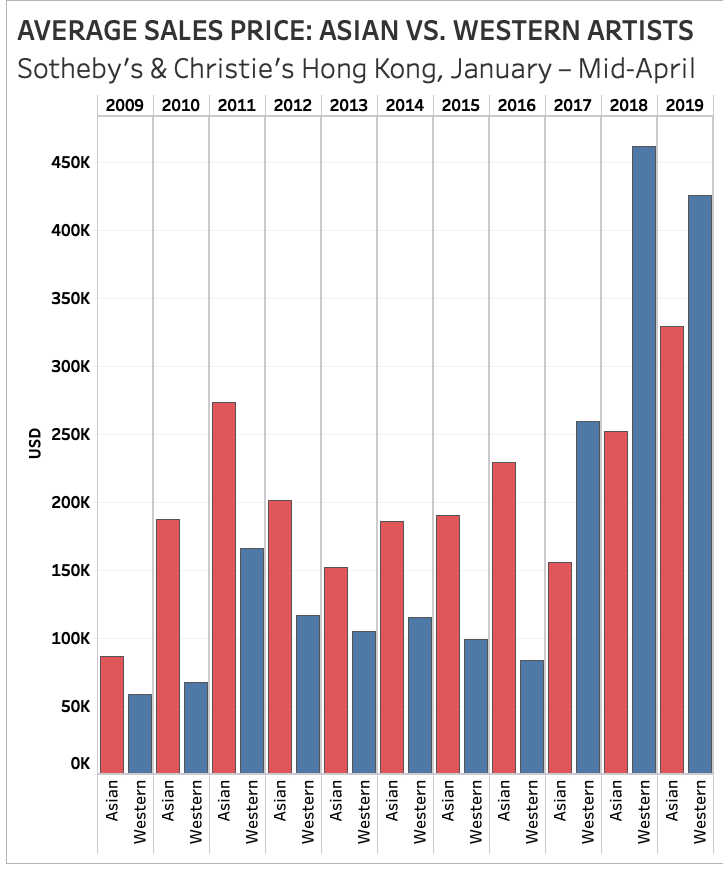
© artnet Price Database 2019.
Even though Asian art still vastly outperforms Western art at auction in Hong Kong overall, there are a few signs that selling work there by non-Asian artists—if it is chosen carefully and has international appeal—can be an increasingly savvy move.
The biggest indicator is this: When it comes to the average price per lot, Western artists have now trounced their Asian counterparts for the third consecutive year. So far in 2019, the average work by a non-Asian artist has sold for $425,453 in Hong Kong, while the average work by an Asian artist generated about 25 percent less cash, at only $329,721.
Sales volume paints a similar picture as sales value too. The number of lots by Asian artists that found buyers in Hong Kong has decreased for the second year in a row, meaning that prices must continue to rise to fuel the dramatic increase in total sales. (We’ve seen a similar dynamic in the global art market writ large, where supply is decreasing but total sales are rising.)
The number of works sold by Western artists, on the other hand, hit an all-time high in 2019, more than doubling the 2018 total. So while the supply of all fine artworks may be shrinking at auction houses worldwide, supply of works by Western artists is growing in Hong Kong’s two biggest salesrooms.
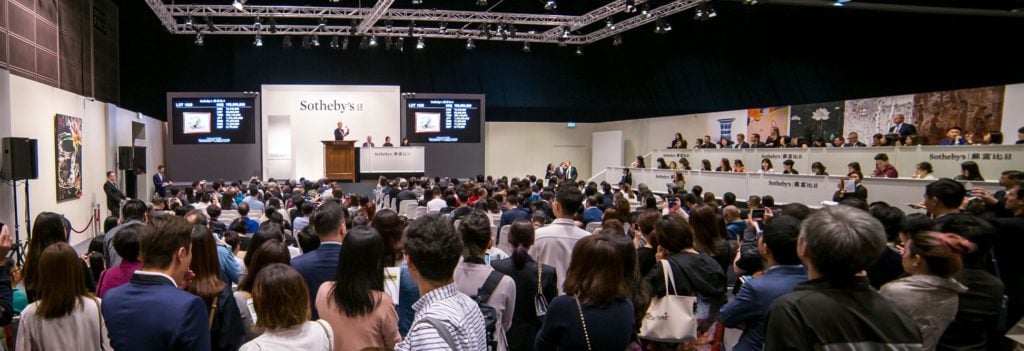
The salesroom at Sotheby’s Hong Kong during its slate of spring 2019 auctions. Image courtesy of Sotheby’s.
Notably, one blue-chip Western artist who has received some but not much exposure in Asia—Julie Mehretu—saw a new auction record set for her work last week at Sotheby’s Hong Kong. The painting Black Ground (Deep Light) (2006) more than doubled its high estimate to generate $5.6 million.
Of course, we don’t know whether the buyer was Asian—but the result suggests that Hong Kong sales are becoming destinations for work by contemporary Western artists that just a few years ago would have gone into evening sales in London or New York instead, even though they would have had a greater chance of being drowned out in those more traditional markets.
Experts note there is still a ways to go to cultivate a booming yet sustainable market for Western art in Asia. The dealer Brett Gorvy of Lévy Gorvy told artnet News, “A lot of conversations [with Chinese clients] are still focused on, ‘Why should I be buying Western art?’” But the tide is shifting. “In the past two years I’ve seen enormous growth in terms of the number and spending power of Chinese collectors in their 20s and 30s,” he said. And, as noted above, indications point to this younger generation being more open to buying international art.
The upshot? In the years ahead, if the average sales price for artists from both categories holds, if Asian collectors continue to increasingly look to the West, and if the supply of work by non-Asian artists continues to grow, Westerners could begin to close the gap on their Asian counterparts in the aggregate, not just on a work-by-work basis. Regardless of what happens, though, the past decade’s results show that Hong Kong’s market is changing fast—and it’s far too important to ignore.
Methodology: This article examines sales at fine art auctions held between January 1 and mid-April at Christie’s and Sotheby’s Hong Kong between 2009 and 2019. For this analysis, artists who have dual nationalities, one of which is Asian, were included in the Asian category. An important caveat: These figures reflect winning bids, but late payments and outright defaults continue to be major challenges for the Chinese art market, so results may not always reflect how much money actually changed hands. All sales values are denominated in US dollars and include buyer’s premiums. All data comes courtesy of the artnet Price Database and artnet Analytics Reports.